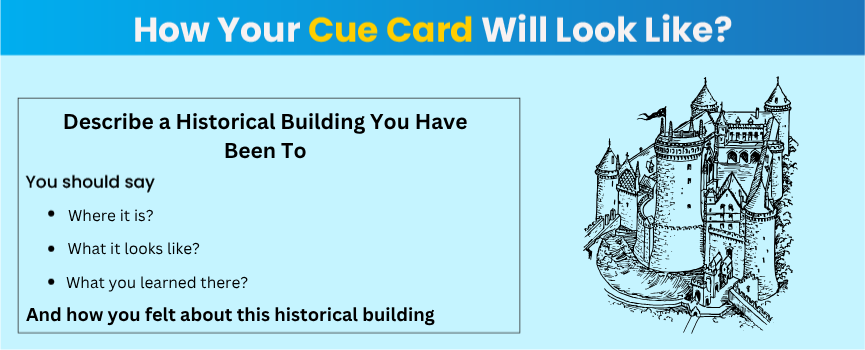The cue cards in the IELTS speaking part 2 generally fall in broad categories like people, things, events, activities, and places. Where you will have to describe personal experiences, daily life, opinions, and general knowledge. And one of these topics can be “Describe a Historical Building You Have Been To.” This might look like a simple cue card topic, but if you combine it with the exam pressure and one-minute preparation time, it can get a little difficult for almost anyone. But don’t worry, we have given three sample answers to this IELTS cue card topic, along with potential follow-up questions and their ideal reply. Read on!

Table of Contents
The IELTS speaking section is divided into three parts:
Part 1: Introduction and Interview
Part 2: Long Turn (Cue Card)
Part 3: Discussion
Its second part is the IELTS cue card section, also known as the Long turn. In the cue cards, you will get prompts regarding various topics, and you will have to talk about them for 1-2 minutes. These topics can come from a wide range of categories, but will be mainly about something you have done or about your opinion. For example, “Describe a Historical Building You Have Been To” and so on.
You will also get one minute of preparation time so that you can understand the topic and jot down things that you would like to speak about. The main aim of the IELTS cue cards is to assess your ability to speak on a topic at length and how coherently and fluently you can speak in English.
In the topic “Describe a Historical Building You Have Been To”, you will have to talk about a historical building you have visited that you can talk about in detail. The building can be a museum, a castle, a church, a monument, or any building with historical significance.
The simplest way to answer the IELTS cue card in a way that you meet all the requirements and achieve fluency and coherence is by following these common best practices below:
1. Utilise the given one-minute preparation time completely and brainstorm ideas and structure your response into intro, body, and conclusion.
2. Read carefully so that you understand the topic and what you are expected to include in your response.
3. Jot down all the points that you can include in your response to give it a better direction.
Lastly, avoid diverging from the topic and including anything that is not quite relevant.
In addition to this, in the Cue card, you will also get a few points that will be related to the topic “Describe a Historical Building You Have Been To.” When you talk about the topic, you have to make sure that you include all these points in your response. These are great because they give your answer a sense of direction and can help you a great deal.
Here are the pointers that you’ll get in your cue card for this topic:
Below is an image of how your cue card might look like for the IELTS speaking section. Check it out:
Now that you have a better understanding of the cue card, what it is, and what it looks like. Let’s go through three samples for the topic “Describe a Historical Building You Have Been To” to help you better understand how you can answer this.
In this first sample, we have given a basic idea about how you can incorporate these four pointers in your response and what you need to talk about in IELTS speaking part 2. Take a look:
One historical building that I have been to, which truly fascinated me, was the Red Fort. I went there a couple of years ago during my family trip, and to this date, its impression has not left me.
The Red Fort is located in Delhi, India, and more specifically in the heart of Old Delhi. It is one of the most iconic landmarks in India and is also a UNESCO World Heritage Site, which was built in the 17th century. What makes it even more fascinating is that it was built by the Mughal emperor Shah Jahan, who also commissioned the Taj Mahal.
The Red Fort looks exactly how one would imagine because of its name. It is completely built from red sandstone, with walls that stretch for more than two kilometres. Another interesting thing about it is its architecture, which is something that awes anyone who sees it. It is a beautiful blend of Persian, Timurid, and Indian styles, with detailed carvings, beautiful arches, and impressive courtyards. Once you enter the Red Fort, you will come across halls, gardens, and some small museums, but what truly captured my attention was the Diwan-i-Khas, or the Hall of Private Audiences.
So we opted for the guided tour, through which I learned so much about the colonial and pre-colonial history of India. I also learned about the kind of role this place played during the independence movement. And to this day, every year on Independence Day, the Prime Minister still hosts the national flag from its ramparts.
I don’t think I can put into words what or how I felt when I visited this amazing place. In all honesty, the Red Fort was just plain grand. Everything about it feels very grand, especially because of how well it has been preserved. When I was walking through its corridor, I felt as if I was stepping back in time.
For me, visiting the Red Fort was not just another family trip, but it was also an eye-opening experience which ended up creating a lasting impression. There, I did not just enjoy its architectural brilliance but even got a chance to connect with my country’s history on a deeper level.
In this next sample, we have created a response that has a special focus on coherence and fluency so that you can get a Band score of 8+ in the IELTS speaking section. Check below:
A historical building that I have been to that I would like to talk about is the Edinburgh Castle in Scotland. I visited that last summer during a trip to the UK with my friends, and the castle left me both impressed and awed, which ended up being the highlight of my journey.
As the name already suggests, the castle is in Edinburgh, which is the capital of Scotland. It is more specifically located in the centre of Edinburgh and sits on the top of the castle rock, which is a volcanic rock. That rock is the reason why the castle has an elevated position above the city skyline.
So, the castle looks like something you would see in a medieval movie; it has thick walls, tall towers, and a huge gatehouse. Once you enter the castle, you will find multiple historic buildings like the Royal Palace and the Great Hall, and on top of the castle, you’ll get a panoramic view of the city.
I learned so much about the castle, but what intrigued me was its long and complicated history. There were things like wars and sieges over the centuries, and it is one of the most attacked places in the UK. I also learned about Mary Queen of Scots and saw the room where her son, James VI, was born.
To put what and how I felt at the castle of Edinburgh is a little tough because it’s simply breathtaking. The architecture, the stories behind it, and how it was preserved are simply fascinating. And all of these just made me appreciate how much history a single place can contain.
So yes, visiting Edinburgh Castle was an experience that has left a lasting impression on my life. It has made me connect with Scotland’s past and given me a deeper appreciation for its culture and heritage. I would highly recommend it to anyone interested in history or architecture.
In this last sample of a cue card for IELTS speaking part 2, we have used good vocabulary words so that you can score well in the lexical resources of the IELTS exam.
A historical building that I have been to that I would like to talk about is the Colosseum, an iconic monument that not just me but almost every kid grew up learning about. It’s the living personification of the ancient world and a symbol of what the Roman Empire looked like.
The Colosseum is located in Rome, Italy and is hard to miss because of its massive size. If I remember this correctly, it was built sometime 2,000 years ago and is an enormous stone amphitheater that is built to host up to 50,000 spectators. But over time, it has started to deteriorate, mainly because of earthquakes and time. However, it is still standing tall, which shows the architectural ingenuity and its historical importance.
The building is made up of travertine limestone and concrete and has arched entrances, tiered seating, and underground chambers. These chambers reveal a lot about Roman engineering and how advanced it was for its time. When I walked through the corridors and looked down into the central arena, I could almost imagine how one would feel during real events in ancient times.
So we took the guided tour and learned about how the Colosseum served not only as entertainment but also as a tool of political propaganda. But what truly intrigued me about learning about it was that it truly is the reflection of the kind of power the Roman emperor might have. I also learned about the mechanisms beneath the arena that allowed for wild animals and props to be lifted suddenly onto the stage.
For me, emotionally, the experience was once in a lifetime; I was just awed by its scale and the detail of the structure. I also felt a sense of melancholy, knowing that the events held there often involved suffering and violence.
So yeah, the Colosseum was the place that made a major impact on how I see life. It felt like stepping into a completely different world, both culturally and emotionally. It reminded me how architecture can be a powerful storyteller, preserving the legacy of civilisations long gone.
In the IELTS exam, you also get a score based on how good your vocabulary for IELTS is. Lexical resources refer to how well you can choose the right words and phrases to express yourself effectively. Below is a list of all the vocabulary words that we used in our cue card response examples above:
| Word | Simple Meaning |
|---|---|
| fascinated | Very interested or amazed |
| impression | The feeling or idea you get about something |
| landmarks | Famous or important buildings or places |
| commissioned | Officially asked or ordered to be built or done |
| opted | Chose or decided |
| ramparts | High walls built for protection in old buildings |
| preserved | Kept safe or in good condition |
| elevated | Raised or higher than the ground |
| medieval | From the Middle Ages (around 500 to 1500 AD) |
| panoramic | Wide and full view of an area |
| intrigued | Curious or very interested |
| personification | Giving human qualities to non-human things |
| enormous | Very large |
| amphitheatre | A large open building for shows or sports |
| spectators | People who watch an event |
| ingenuity | Cleverness or smart ideas |
| propaganda | Messages used to influence people’s opinions |
| mechanisms | Parts that work together in a machine or system |
| melancholy | A deep, quiet sadness |
As we mentioned above, the IELTS speaking section is divided into three parts. The cue card is the second part, and the third is follow-up questions. Once you are done with your response, the third part of the IELTS speaking will begin, where the examiner will ask you a few follow-up questions regarding the topic “Describe a Historical Building You Have Been To” and your response.
This will last about 4-5 minutes and will assess your ability to elaborate, express opinions, and discuss broader issues related to the Part 2 topic. Below are a few follow-up questions that you can get along with their ideal answers:
1. Why do you think historical buildings are important?
I think historical buildings are very important because they allow us to look back in the past and understand how things were back in the olden days. They also help us understand what people used to value and how our societies have evolved. And I think without them, we will lose a part of our heritage.
2. How do you think historic monuments contribute to a society's cultural identity?
The way I think these historic monuments contribute to our or any society’s cultural identity is by acting as a symbol. I think they also show a shared history or a collective memory that reminds people of important events, figures, or values from the past. For example, if we talk about a war memorial, it reflects courage and sacrifice. Similarly, a palace might show the royalty and tradition of a city.
3. Are buildings now better than those in the past? Why?
I don’t think we can compare them, because the old building serves completely different needs (except for a few) than the new buildings do today. If we talk about safety, convenience, and materials specifically, then buildings of today are the best. But if we talk about architecture, craftsmanship, and artistic charm, then the historic buildings were really good.
4. Do you think it's worth the money to preserve old buildings?
Yes, I think it is completely worth the money to preserve old buildings because that way we are investing in our historical and cultural legacy. And both of them are an important part of society. While it is true that restoration can get costly, the value they bring in terms of education, tourism, and community identity outweighs the expense.
5. What is the impact of tourism on historic monuments?
Tourism can have both a negative and a positive impact. If we talk about the positive side, then it generates income for maintenance and raises awareness about the importance of preserving history. However, excessive tourism can cause wear and tear, pollution, and even structural damage to fragile sites. That’s why it’s important to promote sustainable tourism practices, like limiting visitor numbers and educating tourists on how to respect these places.
To maximise your scores in the IELTS cue card topic “Describe a Historical Building You Have Been To”, you can follow some of our tips below:
1. Make sure that you choose a building that you can describe well and not something that you will have to think about a lot.
2. Utilise the one-minute time to jot down points and keywords that you can use in your response.
3. In the main body of your response, make sure that you cover every point given in the cue card and try not to deviate from the topic.
4. To make your response even more engaging and intuitive, try to include examples, idioms, reasons, and explanations behind your opinion.
5. Lastly, show your ability to use varied sentence structures.
In conclusion, IELTS speaking part 2 can get a little difficult for some test takers who are not used to speaking in English daily. And especially when it comes to topics like “Describe a Historical Building You Have Been To”, where you have to generate ideas and express them coherently without immediate prompts. However, in addition to our sample responses and tips above, you can also take online IELTS Classes from our experts at Gradding.com to get your desired band score. Just remember, the examiner is trying to assess your English speaking skills, not how good your historical knowledge is. Take a moment, and answer to the best of your ability!

We are available in :
BangaloreAhmedabadJaipurHyderabadKeralaPuneChandigarhMumbaiGurgaonChennaiKolkataTrivandrumNoidaKochiCalicutKottayamKollamThrissurIndoreUdaipurdisclaimer:logos and other registered trademarks of universities used on this platform are held by their respective owners. Gradding does not claim ownership or association on them, and their use is purely for informational and illustrative purposes.





